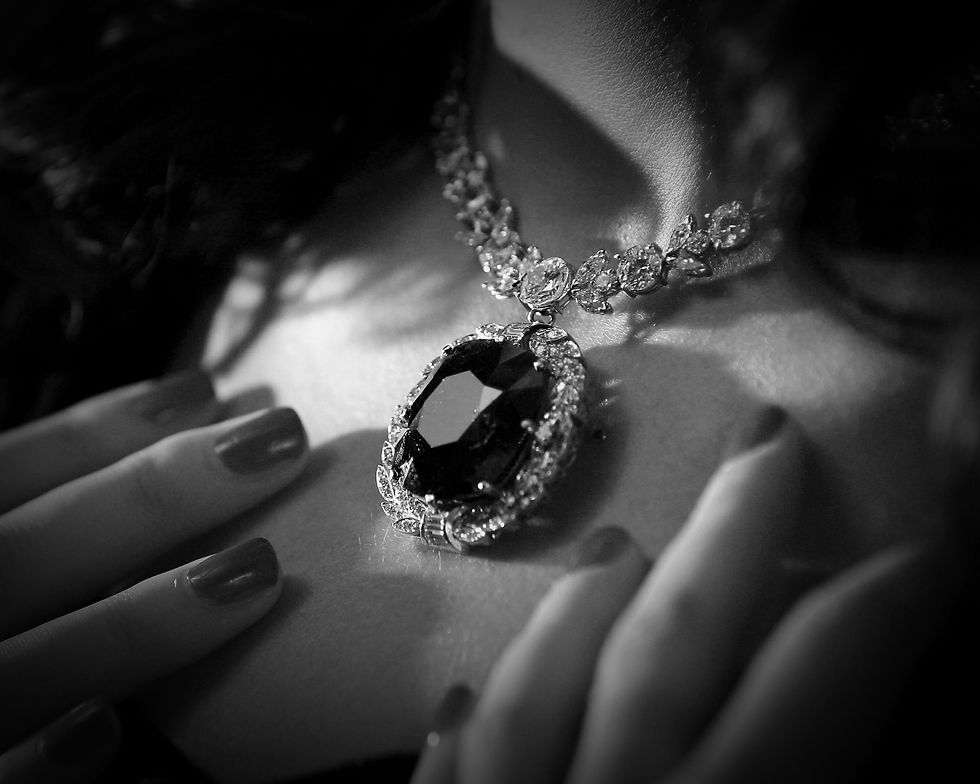Two diamonds from the Indian subcontinent, the White Orlov and the Black Orlov have histories shrouded in myth and legend, both of which found their way to Europe during the days of the British Raj.

As for the White Orlov, it is now part of the Diamond Fund of the Moscow Kremlin. It weighs 189.62 ct and has not been recut into a more modern style from the modified rose-cut style it was given earlier.
The Russian government has put up a virtual tour of the spectacular collection of gems and nuggets.
Originating from the Kollur Mines in Golconda, it was placed in was once an eye in a statue of a deity a temple deity Sriranganathar, present-day Southern India. The statue was located in a temple with seven enclosures.
Non-Hindus were not allowed past the fourth enclosure. After the Carnatic wars in Srirangam, a French deserter in disguise gained access to the inner temple by pretending to worship there for years. After proving himself and entering the centre enclosure, he stole the diamond.
In around 1750, the deserter fled to find protection and a buyer with the British army. The diamond passed through the hands of many merchants and eventually found itself in Amsterdam, where Count Grigory Grigorievich Orlov purchased it and gave the diamond his name.
Count Orlov gifted the diamond to Catherine the Great of Russia in an effort to regain her affections after she ended their years-long affair. She had her royal jewellers create a sceptre that featured the Orlov diamond. And there it shall stay, perhaps for eternity.

The legend of the Black Orlov follows a similar trajectory. It weighs 67.50 carats and is the 7th largest black diamond in the world.
Pried out of the eye of an idol in Pondicherry, it is also known as the Eye of the Idol. As for the idol, sources are disputed, amongst it being the Hindu God Brahma or Shiva. After exchanging multiple hands, the dealer J.W. Paris brought it to America in 1932.
His business began to fail soon after he took possession of the Black Orlov. As a result, he developed a severe case of anxiety, and a year after he sold the stone, he jumped to his death from a skyscraper. It is unclear if he killed himself in Manhattan or in New York City.
Later, in the 1900s, the diamond was owned by two Russian princesses, Leonila Galitsine-Bariatinisky and Nadia Vygin-Orlov (who gave the diamond its current name). Eerily, both of them are believed to have leapt to their deaths from tall buildings after owning the stone.
It is possible that Nadia may be an anglicised version of the name of Princess Nadezhda, also spelt Nadejda, for there was no Romanov Princess who went by the name of Nadia! So, who could this mystery Princess be?

We came across a possible answer: Princess Nadezhda Petrovna, who was later known as Nadezhda Petrovna Orlova; the third child of Grand Duke Peter Nikolaevich of Russia and his wife, the former Princess Milica of Montenegro.
The Orlov Princess was engaged to Prince Oleg Constantinovich of Russia before the First World War. After he was killed in action, she married Prince Nicholas Vladimirovich Orlov in Crimea, in April 1917.
They were among the Romanovs who escaped the Russian Revolution in 1919 aboard the British ship HMS Marlborough.
Their baby daughter, Princess Irina Orlova, born in March 1918, was the youngest passenger aboard the ship.

Another interesting discovery on myths around the Black Orlov is that many sources briefly mention a legend where the Black Orlov was given as ransom by the Sheik of Kashmir to the Sultan of Turkey after he kidnapped Princess Rasheetah, with no details of the incident whatsoever.
It is plausible that it may have been a part of British and French propaganda against the Sultans of Turkey, for political reasons, during the years of the war for no such incident is mentioned in Pakistani, Indian or Turkish lore!
The Sheikhs never ruled Kashmir, no such incident occurred historically, and there are no traces of how the diamond returned to India. The timelines don't seem to match either. A diamond cannot possibly be in possession of Turkish and Russian royals simultaneously.
In1950, the diamond was acquired by Mr Wilson, who had it recut to the 67.5-carat diamond it is today, in an attempt to break the curse. Since then, no more deaths have surrounded the gem.

Currently, the stone is set in a 108-carat diamond brooch attached to a 124-carat diamond necklace, effectively making it one of the most impressive pieces of jewellery in existence.
Owned by Dennis Petimezas, an established trader of gems and jewellery, now retired, says he is "pretty confident" the curse is broken, and he has no fear of it.
Is it so? Only time shall tell!
Comments